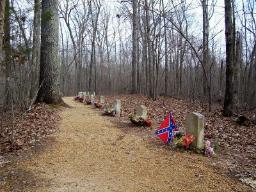


Brices Cross Roads Victims?
One theory is that the graves
may contain men who died
from wounds.
One theory is that the graves
may contain men who died
from wounds.
Lonely Graves of Soldiers
The graves are maintained by
the National Park Serve as
part of the Natchez Trace.
The graves are maintained by
the National Park Serve as
part of the Natchez Trace.
ExploreSouthernHistory.com - Unknown Confederate Graves, Mississippi
ExploreSouthernHistory.com - Unknown Confederate Graves, Mississippi
Unknown Confederate Graves - Natchez Trace, Mississippi

| Unknown Confederate Graves Thirteen unknown Southern soldiers lie buried on a hill by the route of the original Natchez Trace. |
Unknown Civil War Soldiers
On a lonely hill off the Natchez Trace Parkway
just north of Tupelo, Mississippi, can be
found a moving reminder of the human cost
of the deadliest war in American history.
Thirteen graves of unknown Confederate
soldiers lie in a long line overlooking a
preserved section of the original Natchez
Trace.
What happened to these men, along with
their names, has been lost to time. Some
theorize they may have been Southern
soldiers that died following the Confederate
evacuation of Corinth, Mississippi. Others
believe they were wounded soldiers that died
following the nearby Battle of Brices Cross
Roads.
Both events led to heavy losses. Corinth was
evacuated in 1862 following the Battle of
Shiloh. Tens of thousands of men were killed
and wounded in the fight and following
retreat of the Southern army. Sickness had
also ravaged the Confederate camps around
Corinth, also causing many soldier deaths.
The Battle of Brices Cross Roads took place
on June 10, 1864, and was a major victory for
the troops of Major General Nathan Bedford
Forrest. The battlefield is only about ten
miles (as the crow flies) from the little burial
ground. It is certainly possible that these
were wounded Confederate troops from the
battle who died in the day sand weeks
following. The fact that so many are clustered
together suggests there may have been a
camp or hospital in the vicinity.
It is also possible that the men were the
victims of sickness. Sanitary conditions and
other causes led to thousands of deaths
from illness during the Civil War. More men
died from disease and exposure during the
Civil War than from any other cause.
The graves are an unusual site along the
Natchez Trace. Most of the historic roadway
had been abandoned by the time of the Civil
War, but the section passing the little burial
plot was evidently used by soldiers marching
through Northeast Mississippi.
The trail leading to the graves passes
through a deeply worn section of the original
trace. It is one of a number of places along
the parkway where visitors can walk the
original route of the original road. Here it was
worn deep by the passage of people and
horses.
just north of Tupelo, Mississippi, can be
found a moving reminder of the human cost
of the deadliest war in American history.
Thirteen graves of unknown Confederate
soldiers lie in a long line overlooking a
preserved section of the original Natchez
Trace.
What happened to these men, along with
their names, has been lost to time. Some
theorize they may have been Southern
soldiers that died following the Confederate
evacuation of Corinth, Mississippi. Others
believe they were wounded soldiers that died
following the nearby Battle of Brices Cross
Roads.
Both events led to heavy losses. Corinth was
evacuated in 1862 following the Battle of
Shiloh. Tens of thousands of men were killed
and wounded in the fight and following
retreat of the Southern army. Sickness had
also ravaged the Confederate camps around
Corinth, also causing many soldier deaths.
The Battle of Brices Cross Roads took place
on June 10, 1864, and was a major victory for
the troops of Major General Nathan Bedford
Forrest. The battlefield is only about ten
miles (as the crow flies) from the little burial
ground. It is certainly possible that these
were wounded Confederate troops from the
battle who died in the day sand weeks
following. The fact that so many are clustered
together suggests there may have been a
camp or hospital in the vicinity.
It is also possible that the men were the
victims of sickness. Sanitary conditions and
other causes led to thousands of deaths
from illness during the Civil War. More men
died from disease and exposure during the
Civil War than from any other cause.
The graves are an unusual site along the
Natchez Trace. Most of the historic roadway
had been abandoned by the time of the Civil
War, but the section passing the little burial
plot was evidently used by soldiers marching
through Northeast Mississippi.
The trail leading to the graves passes
through a deeply worn section of the original
trace. It is one of a number of places along
the parkway where visitors can walk the
original route of the original road. Here it was
worn deep by the passage of people and
horses.
The original markers for the graves had all
but disappeared by 1940, when Senator
Theodore Bilbo arranged for marble stones
to be placed on the graves. These, in turn,
were stolen and were replaced with the
current markers by the National Park Service.
The historic site is located on the Natchez
Trace Parkway near mile marker 270, just
north of Tupelo. The graves and old trace
section are only a few miles north of the
Tupelo Visitor Center on the parkway, which
provides information on historic sites and
points of interest along the parkway.
Also of Civil War interest nearby is Tupelo
National Battlefield, where Nathan Bedford
Forrest was wounded trying to turn back a
Union expedition.
Please click here to visit our main page on
the Natchez Trace.
but disappeared by 1940, when Senator
Theodore Bilbo arranged for marble stones
to be placed on the graves. These, in turn,
were stolen and were replaced with the
current markers by the National Park Service.
The historic site is located on the Natchez
Trace Parkway near mile marker 270, just
north of Tupelo. The graves and old trace
section are only a few miles north of the
Tupelo Visitor Center on the parkway, which
provides information on historic sites and
points of interest along the parkway.
Also of Civil War interest nearby is Tupelo
National Battlefield, where Nathan Bedford
Forrest was wounded trying to turn back a
Union expedition.
Please click here to visit our main page on
the Natchez Trace.

The Natchez Trace
The graves are located along
a preserved section of the
original Natchez Trace.
The graves are located along
a preserved section of the
original Natchez Trace.

The Old Trace
The short trail leading to the
graves follows a deeply worn
remnant of the original
Natchez Trace.
The short trail leading to the
graves follows a deeply worn
remnant of the original
Natchez Trace.

Natchez Trace Parkway
Tupelo, Mississippi
Elvis Presley Birthplace
Tupelo National Battlefield
Brices Cross Roads National Battlefield
Chickasaw Village and Fort
Historic Sites in Mississippi
Explore other Southern Historic Sites
Tupelo, Mississippi
Elvis Presley Birthplace
Tupelo National Battlefield
Brices Cross Roads National Battlefield
Chickasaw Village and Fort
Historic Sites in Mississippi
Explore other Southern Historic Sites



Custom Search
| Copyright 2011 by Dale Cox All rights reserved. |


